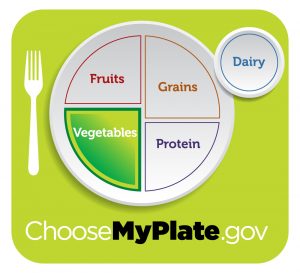Bulletin #4395, Eating for Health with MyPlate: Vegetables
Prepared by Extension Educator Kate Yerxa and Extension Specialist Leslie Forstadt, University of Maine Cooperative Extension. Reviewed by Extension Educators Alan Majka and Jane Conroy, University of Maine Cooperative Extension.
For information about UMaine Extension programs and resources, visit extension.umaine.edu.
Find more of our publications and books at extension.umaine.edu/publications/.
Like most Americans, Mainers eat too much fat, sugar, sodium, and refined grains. These Eating for Health with MyPlate fact sheets can start you down the path to good health. Each one is about a different part of the 2020-2025 Dietary Guidelines for Americans and MyPlate healthy eating guidelines. You can learn what each part is, why it’s important, and how it matters to you and to your family. The MyPlate food groups are Grains, Vegetables, Fruits, Dairy, and Protein. This fact sheet explains the Dairy Group.
Which foods are in the Vegetables Group?
All vegetables are part of the Vegetables Group. So is 100% vegetable juice. Vegetables can be raw, cooked, fresh, frozen, or canned. Vegetables include foods like peas, corn, green beans, spinach, potatoes, cabbage, lettuce, carrots, tomatoes, and broccoli.
How much of this food group should adults eat?
The amount of vegetables needed each day is different for everyone. It depends on your personal calorie (energy) needs. The average adult needs about 2,000 calories a day. In a 2,000 calorie diet, you need 2 1/2 cups of vegetables a day. One cup of vegetables is equal to
- 2 cups of raw leafy greens (like spinach, lettuce, or a tossed salad),
- 1 cup cooked or raw vegetables (like carrots, corn, or peas),
- 1 cup of cooked dry beans (like kidney, black, or pinto beans), or
- 1 medium baked potato (about 3 inches long).
Why vegetables?
Vegetables are low in calories and fat. Eating a rainbow of vegetable colors brings the most health to your diet. Dark green leafy vegetables are more healthful than iceberg lettuce.
How to eat more vegetables
- Keep frozen and canned vegetables on hand as a quick and easy way to add vegetables to meals.
- Try buying vegetables when they are in season. They will cost less.
- Add shredded or chopped vegetables to spaghetti or pizza sauce.
- Add frozen vegetables to prepared soups.
Kids and vegetables
- Start your dinner with a salad, or some cut-up veggies and dip. If you take time and eat salad first, you’ll have more time at the table to talk with your kids about their day. Then everyone can pitch in to get the rest of the meal ready.
- Ask your child to pick two vegetables to try at dinner. Different colors can be fun, like orange carrots and yellow squash. Your child can mix them together before or after you cook them. If your child doesn’t like them mixed, serve them side by side.
- Let kids decorate salads! Put the lettuce in a big bowl. Put the other salad ingredients in smaller bowls. Ask your child to put each vegetable on the salad. Carrot and radish pieces can be polka dots. Tomatoes and cucumbers can make circles.
- At the store, ask your child to help you find frozen or canned vegetables that don’t have salt in them. Your child can also help you find vegetables that are not in a sauce. Decide to add your own salt and make your own sauce at home.
- Ask your child to pick a vegetable to pack for the next day’s lunch. Then you can prepare that vegetable for dinner, and pack a snack bag of the raw vegetable for lunch. A perfect example is carrots. You can serve steamed carrots with a little olive oil and salt and pepper for dinner. Then put raw carrots in the next day’s lunch.
- Have your kids help grow vegetables or visit a vegetable garden. The more your child knows about where vegetables come from, the more they’ll like them.
How to build a healthy plate
Balance calories
- Enjoy your food, but eat less.
- Avoid oversized portions.
Eat more of . . .
- Make half your plate fruits and vegetables.
- Make half your grains whole.
- Switch to fat-free or low-fat (1%) milk.
Eat less of . . .
- Compare sodium in foods like soup, bread, and frozen meals. Choose the foods with lower numbers.
- Drink water instead of sugary drinks.
Sources
U.S. Department of Agriculture and U.S. Department of Health and Human Services. Dietary Guidelines for Americans, 2020-2025. 9th Edition. December 2020. Available at DietaryGuidelines.gov.
U.S. Department of Agriculture. MyPlate website. 2021. https://www.myplate.gov

Information in this publication is provided purely for educational purposes. No responsibility is assumed for any problems associated with the use of products or services mentioned. No endorsement of products or companies is intended, nor is criticism of unnamed products or companies implied.
© 2011, 2017, 2021
Call 800.287.0274 (in Maine), or 207.581.3188, for information on publications and program offerings from University of Maine Cooperative Extension, or visit extension.umaine.edu.
In complying with the letter and spirit of applicable laws and pursuing its own goals of diversity, the University of Maine System does not discriminate on the grounds of race, color, religion, sex, sexual orientation, transgender status, gender, gender identity or expression, ethnicity, national origin, citizenship status, familial status, ancestry, age, disability physical or mental, genetic information, or veterans or military status in employment, education, and all other programs and activities. The University provides reasonable accommodations to qualified individuals with disabilities upon request. The following person has been designated to handle inquiries regarding non-discrimination policies: Director of Equal Opportunity and Title IX Services, 5713 Chadbourne Hall, Room 412, University of Maine, Orono, ME 04469-5713, 207.581.1226, TTY 711 (Maine Relay System).


